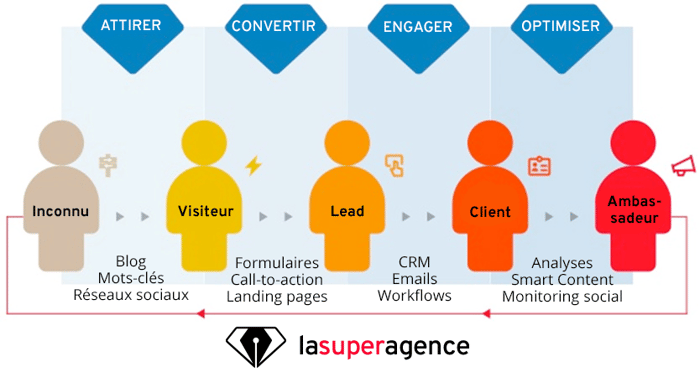We are hearing more and more about Inbound Marketing.
Far from being a mere fad, this is a totally new approach to the relationship between the customer and the company.
How do we define Inbound Marketing?
Nothing could be simpler, on the surface: just type those two words on Google and, within half a second, your favorite search engine returns nearly 9 million results and several pages of definitions.
Except that these seem to be mostly aimed at industry professionals. Are we able to explain what Inbound Marketing, which promises to be so revolutionary, is to someone who has never opened a Kotler & Dubois, nor segmented any market?
Let's start with the complicated part:
What is marketing?

Marketing and communication are often mistakenly confused!
Marketing... is not selling (that's business), nor is it talking about yourself (that's communication).
In short, marketing is about better understanding the consumer to sell more (cross-selling)and better (up-selling).
This is not simply a mental construct. On the contrary, it is a widespread practice.
Companies analyze their market ("market" in English) and adapt accordingly to get more customers, and sell them more products and services and/or for a higher price.
This process seems, all in all, to be a matter of simple common sense. Over the centuries, it has gradually become streamlined to become a profession in its own right.
What is outbound marketing?

Shout your message from the rooftops. Is it really effective?
To promote themselves, many companies use techniques like pop-up ads or banners.
This works but has its limitations. They may bore the people being canvassed.
After a while, these may get tired of it. They will eventually ignore the messages altogether.
That's what's going on right now on the Internet. If you translate the store owner's initiative into the digital world, it involves sending emails or pushing promotional banners on sites.
These techniques belong to what is called Outbound Marketing - outbound marketing.
Thanks to it, companies will seek out new customers, multiplying channels, even if it means saturating consumers.
So, Internet users respond by directing emails to the junk mail box or blocking ads on their browsers .
So to be heard, we'll have to send more messages, more emails, more calls.
...or we'll have to take the problem in reverse and invest in Inbound Marketing!
What is Inbound Marketing
Here we go. So Inbound Marketing is... the opposite of Outbound Marketing.
This time, we are looking to get the customer to come, to attract them to our website without resorting to the costly methods that are online marketing campaigns.
How? By betting everything on the search ability of Internet users.
To put it simply, Outbound Marketing is about catching customers and persuading them to buy while Inbound Marketing is about enchanting customers and convincing them to buy.

Attract, convert, engage and optimize are the 4 steps of Inbound Marketing
To do this, Inbound Marketing uses a four-step process.
1. Attract
First, it seeks to create a first contact worthy of the Internet user's interest, using quality content, spread especially on social-networks.
If this content - text, video, infographics, etc. - is deemed relevant by this Internet user, he or she will be prompted to come and find out more about the website that originated the content.
2. Convert
Once on the site, Inbound Marketing will aim to entice that web user to get more information, including leaving his or her contact information so he or she can be contacted.
The intelligence of Inbound Marketing will then consist of identifying the visitor's motivations to offer them the product or service they are really looking for.
3. Engage
When the lead is registered in your database, you will be able to provide them with regular information via a process called Nurturing.
With tools like Marketing Automation or lead scoring, you'll be able to get better and better at qualifying your prospects so that they become sufficiently mature for your salespeople.
These will only have to transform these leads into customers!
4. Analyze
Whatever the visitor's behavior, Inbound Marketing will be able to estimate whether the prospect - the "lead" - offers a good chance of buying, or redeeming on the site.
We will then be able to analyze the data of all visitors and deduce the effectiveness of the site. The return on investment of Inbound Marketing will then be possible to evaluate.
If this article has inspired you to learn more about Inbound Marketing, we invite you to ask us questions in the comments section !









